Abstract
This paper outlines a structural qualification process to assess the use of newly developed high-modulus (HM) glass fiber-reinforced polymer (GFRP) bars with headed ends in the joint between concrete bridge barriers and decks. The main goals of the study are to evaluate the structural performance of GFRP-reinforced TL-5 barrier–deck systems under transverse loading and to determine the pullout capacity of GFRP anchorage systems for both new construction and retrofit applications. The research is divided into two phases. In the first phase, six full-scale Test-Level 5 (TL-5) barrier wall–deck specimens, divided into three systems, were constructed and tested up to failure. The first system used headed-end GFRP bars to connect the barrier wall to a non-deformable thick deck slab. The second system was similar to the first but had a deck slab overhang for improved anchorage. The third system utilized postinstalled GFRP bars in a non-deformable thick deck slab, bonded with a commercial epoxy adhesive as a solution for deteriorated barrier replacement. The second phase involves an experimental program to evaluate the pullout strength of the GFRP bar anchorage in normal-strength concrete. The experimental results from the tested specimens were then compared to the factored applied moments in existing literature based on traffic loads in the Canadian Highway Bridge Design Code. Experimental results confirmed that GFRP-reinforced TL-5 barrier–deck systems exceeded factored design moments, with capacity-to-demand ratios above 1.38 (above 1.17 with the inclusion of an environmental reduction factor of 0.85). A 195 mm embedment length proved sufficient for both pre- and postinstalled bars. Headed-end GFRP bars improved pullout strength compared to straight-end bars, especially when bonded. Failure modes occurred at high loads, demonstrating structural integrity. Postinstalled bars bonded with epoxy performed comparably to preinstalled bars. A design equation for the barrier resistance due to a diagonal concrete crack at the barrier–deck corner was developed and validated using experimental findings. This equation offers a conservative and safe design approach for evaluating barrier–deck anchorage.
1. Introduction
The development of epoxy-coated reinforcement as a corrosion protection method was started in the early 1970s. Following successful demonstration projects in the mid-1970s, the adoption of epoxy-coated bars in highway bridges increased significantly, establishing it as the preferred corrosion protection technique. However, the first signs of inadequate field performance were noted in 1986 in Florida bridges, with additional examples reported in the United States and Canada during the 1990s, particularly in bridge barriers [1,2]. In environments subjected to de-icing, severe corrosion was observed on the outer side of the vertical bars on the traffic-facing side of the barrier wall, accompanied by section loss in the horizontal bars after 10 to 20 years of service. An investigation by the Ontario Ministry of Transportation (MTO) [3] indicated that the epoxy coating on steel bars deteriorates after a certain period, resulting in corrosion that leads to concrete cracking and spalling. Consequently, the MTO prohibited using epoxy-coated bars in bridge decks, while permitting the use of non-corrosive glass fiber-reinforced polymer (GFRP) bars to enhance bridge designs, thereby improving life expectancy and significantly lowering maintenance costs.
Traditionally, GFRP bars are anchored to concrete through mechanisms such as friction, mechanical adhesion, and mechanical interlock provided by the profile of the bar’s surface. The necessary embedment length of the bar within the concrete is determined by its bond strength with the surrounding concrete and the specific end condition [4,5], which may include straight ends, 90-degree bends, or 180-degree hooks. In contrast to steel bars, which can be manually bent, GFRP bar bends and hooks are produced in a factory setting and subsequently transported to the construction site for installation. Due to the significant reduction in pullout strength at the curved sections of the bar, attributed to the reorientation of fibers [6,7], GFRP manufacturers have introduced GFRP bars with cast anchorage. This type of headed anchor bar is anticipated to alleviate reinforcement congestion at cast joints.
A limited number of researchers have examined the pullout capacity and bond strength of fiber-reinforced polymer (FRP) bars embedded in normal-strength concrete [8,9], as well as in high-strength concrete [4]. Additional research has focused on the pullout capacity of glass fiber-reinforced polymer (GFRP) bars within fiber-reinforced concrete [10,11], in geopolymer normal concrete [12,13], and in ultra-high-performance fiber-reinforced concrete (UHPFRC) [14,15,16,17,18]. Furthermore, Firas et al. [19] conducted a study on the bond strength of carbon fiber-reinforced polymer (CFRP) bars in UHPFRC.
Recently, some manufacturers specializing in glass fiber-reinforced polymer (GFRP) have launched GFRP bars that incorporate cast-headed ends, aimed at improving their anchorage with concrete. Several researchers have examined the pullout capacity and bond strength of these headed-end GFRP bars in various concrete types, including normal-strength concrete [6,20,21,22,23], high-strength concrete [4,5,24], and geopolymer normal concrete [13]. Johnson and Sheikh [25] conducted experimental studies to assess the viability of employing double-headed GFRP bars as shear reinforcement in concrete beams. Additionally, Sennah and Khederzadeh [26] and Sennah and Hedjazi [27] verified the use of GFRP bars with headed ends in TL-5 barrier design using vehicle crash tests, while verifying the design by loading the barrier–deck overhang to collapse [28,29,30]. Others verified the use of GFRP bar with 180° hook in Test-Level 5 (TL-5) barrier design using a crash test and static tests to collapse [31,32]. Hasaballa and El-Salakawy [33] investigated the behavior of beam–column joints reinforced with GFRP-headed bars under seismic conditions, concluding that the headed bars demonstrated superior seismic performance compared to bent bars. Furtehermore, El-Badry et al. [34] developed and tested a hybrid GFRP-reinforced bridge truss girder system, which incorporated headed-end GFRP bars for improved anchorage at truss joints under both fatigue and static loading conditions.
Bridge barriers, especially in Canada, are subjected to significant quantities of de-icing salts throughout the winter months, which serve as catalysts for the corrosion of conventional steel reinforcement. Figure 1 illustrates a photograph of a deteriorated bridge barrier resulting from the corrosion of steel bars and concrete spalling, highlighting the necessity for an alternative to steel reinforcing bars for the barrier wall. Given that GFRP bars do not possess steel properties, corrosion is effectively mitigated, making them an appropriate substitute [35,36,37,38]. While GFRP bars are resistant to corrosion, their long-term performance may vary based on exposure conditions, and design considerations should account for potential reductions due to environmental effects.
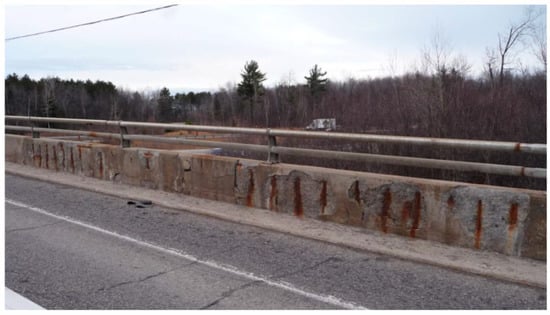
Figure 1.
Photo of a deteriorated reinforced steel bridge barrier in Canada.
The use of GFRP bars in bridge barriers has drawn significant attention due to their corrosion resistance and high strength-to-weight ratio. Nepomuceno et al. [39] and Zheng et al. [40] emphasized that GFRP bond strength is highly sensitive to surface texture, embedment conditions, and environmental exposure, with durability compromised under aggressive agents like chlorides and alkalis. These findings stress the importance of robust anchorage detailing and adequate embedment lengths. Barrier–deck overhang joints for new construction must satisfy demanding load criteria, especially under MASH TL-5 conditions. The NCHRP Report 1078 [41] and Frosch & Morel [42] highlighted the need for stronger anchorage in thinner decks. Arrington et al. [43] showed that optimized anchorage improves impact resistance even with 5-inch deck thicknesses. Khederzadeh and Sennah [30] validated the performance of sand-coated GFRP bars under static loading, supporting their applicability in such configurations.
Precast or replacement of barrier–deck joints benefits from advanced connectors. Zhao et al. [44] and Nguyen et al. [45] tested grouted sleeves and loop-bar connectors, demonstrating high impact resistance. Yu et al. [46] optimized prefabricated connector geometry, while Alaywan [47] and Azimi [48] demonstrated the feasibility of precast alternatives for accelerated bridge construction. Ecklund and Sritharan [49] further supported this through full-scale testing. Patel et al. [50] proposed an innovative precast barrier system improving constructability and safety. Coleman et al. [51] experimentally studied the effect of beam depth on anchorage strength of hooked and headed bars, while Cho and Choi [52] showed that anchorage of barrier posts or curbs is equally critical. A few studies [53,54,55] examined failure modes under horizontal loads. Ahmed et al. [56] and Azimi et al. [57] combined steel and GFRP in post-and-curb systems. Ultra-high-performance concrete (UHPC) was examined as a filling material in the barrier–deck overhang joints, and steel dowels for postinstalled barrier construction were explored to enhance prefabricated barrier strength [58,59]. Finally, recent investigations by Rostami et al. [60] and Azimi et al. [61] confirmed that postinstalled headed GFRP bars with epoxy provide reliable anchorage strength, making them viable for deteriorated barrier replacement on existing decks.
The integration of GFRP bars in bridge construction is on the rise, supported by comprehensive research supported by the Ministry of Transportation of Ontario (MTO) to evaluate the practical use of existing products. Following successful crash tests and static load evaluations on a developed MTO TL-5, GFRP-reinforced barriers [26,30], the MTO established Standard Drawing MTO-S110-92, which outlines the dimensions and GFRP specifications for use by designers and contractors. In this design framework, GFRP bars are employed to reinforce the barrier wall both vertically and horizontally, while headed-end bars are utilized to strengthen the junction between the barrier and the deck. The headed section of the bar is anticipated to enhance load-bearing capacity, thereby facilitating a more efficient design approach. The GFRP bars developed, which possess material strength and modulus of elasticity comparable to those used in the crash-tested barriers from other GFRP manufacturers, are recommended for barrier reinforcement per MTO Drawing MTO-S110-92. Given that GFRP bars are proprietary products, they must undergo evaluation for structural performance in the event of vehicle impact [62].
This paper presents an in-depth investigation into the structural performance of newly developed high-modulus (HM) GFRP bars with headed ends used for anchoring concrete bridge barriers to deck slabs. The research is divided into two main phases. The first phase involves experimental testing of six full-scale TL-5 bridge barrier–deck specimens subjected to transverse loading until failure. These specimens represent three anchorage systems: (i) preinstalled headed-end GFRP bars in a thick non-deformable deck slab, (ii) the same anchorage detail applied to a flexible deck overhang, and (iii) postinstalled straight GFRP bars bonded with epoxy to simulate retrofitting deteriorated barriers. Crack development, failure modes, displacements, and strain evolution were thoroughly monitored and analyzed to assess structural behavior. Besides, the experimental capacities compared to the analytical resistances calculated using the equations proposed in the existing literature [63,64]. In the second phase, direct pullout tests were performed on GFRP bars with various embedment conditions to quantify anchorage capacity and compare it to applied forces at the barrier–deck interface due to vehicle impact. The results are used to validate a design equation for diagonal cracking at the barrier–deck junction and to confirm the adequacy of the GFRP anchorage under factored CHBDC loading. This comprehensive approach supports both new construction and rehabilitation of concrete bridge barriers using GFRP reinforcement.
2. Experimental Program
2.1. Test Specimens
A total of six full-scale Test-Level 5 (TL-5) barrier specimens, each with a length of 900 mm, were constructed and subjected to transverse loading that simulated vehicle impact until complete failure. This was conducted to assess their ultimate load-carrying capacities and the modes of failure at the deck barrier joint. In the case of barrier walls installed on top of solid slab bridges and voided slab bridges, the barrier wall is considered connected to a non-deformable thick slab. Specimen B-1 shown in Figure 2a represents this scenario where the barrier wall is fixed to a 500 mm thick slab resting on the laboratory floor to prevent flexural deformation. The dimensions and GFRP arrangement are identical to the TL-5 barrier specified in MTO Standard Drawings [65]. The barrier is reinforced with 15M GFRP vertical bars at the front face at 300 mm spacing and 13M GFRP vertical bars at the back face of the barrier wall at 300 mm spacing. All vertical GFRP bars are embedded into the deck slab with a vertical embedment length of 195 mm. The deck slab was reinforced in the main direction with M20 steel bars at 100 mm spacing. This barrier specimen represents the interior portions between the expansion joints or ends of the barrier wall. However, the exterior portion of the barrier wall is expected to be more critical than the interior portion when impacted by a vehicle. As a result, MTO Standard Drawing specifies vertical bar spacing at the traffic side of the barrier as half the spacing between similar bars at interior locations. Thus, Figure 2b shows a schematic diagram of specimen B-2 that represents the end segment of the TL-5 barrier on which the vertical reinforcement at the front face of the barrier is doubled. In this case, 15M GFRP vertical bars were used at the front face of the barrier at 150 mm spacing, while the vertical reinforcement at the back face of the barrier was kept as 13M at 300 mm spacing.
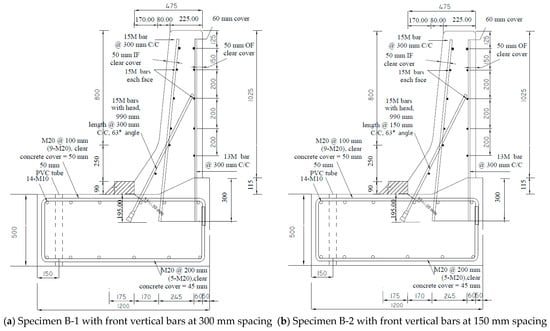
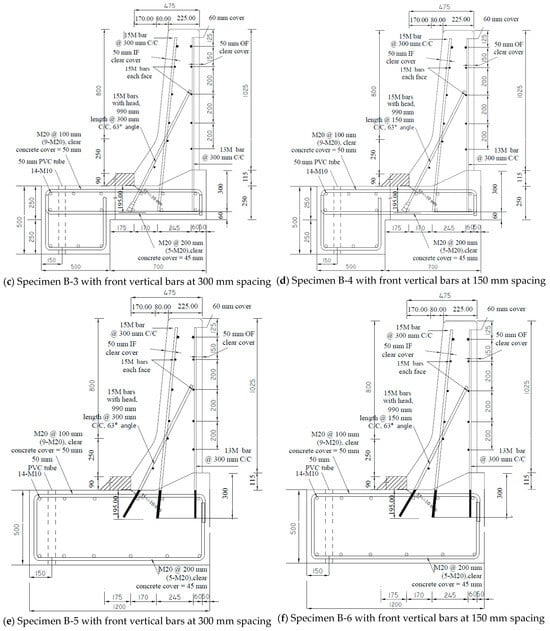
Figure 2.
Concrete dimensions and reinforcement detailing for all specimens.
Specimens B-3 and B-4 represent barrier walls installed over a deck slab overhang in a slab-on-girder bridge. Figure 2c shows a schematic diagram of specimen B-3 that represents the interior segment of the TL-5 barrier. The barrier is reinforced with 15M GFRP vertical bars at the front face at 300 mm spacing and 13M GFRP vertical bars at the back face of the barrier wall at 300 mm spacing. All vertical GFRP bars are embedded into a 250 mm thick deck slab overhang with a vertical embedment length of 195 mm. The deck slab overhang was reinforced in the main direction with M20 steel bars at 100 mm spacing. Figure 2d shows a schematic diagram of specimen B-4 that represents the end segment of the TL-5 barrier on which the vertical reinforcement at the front face of the barrier is doubled. In this case, 15M GFRP vertical bars were used at the front face of the barrier at 150 mm spacing, while the vertical reinforcement at the back face of the barrier was kept as 13M at 300 mm spacing.
Specimens B-5 and B-6 illustrate the scenario of the replacement of the deteriorated bridge barrier in currently existing bridges. Figure 2e shows a schematic diagram of the postinstalled barrier wall in a thick concrete slab at an interior location, on which vertical bars are spaced every 300 mm. The barrier vertical bars are postinstalled into the deck over a vertical embedment length of 195 mm using Hilti epoxy. Figure 2f shows a schematic diagram of the postinstalled barrier wall in a thick concrete slab at an end location, on which vertical bars at the front face are spaced every 150 mm, while the rest of the reinforcement is identical to that in specimen B-5 at the interior location.
A preprepared wood formwork was designed and assembled using steel bolts to cast the specimens as shown in Figure 3a. After casting, the barriers were kept moist for the first four days by applying water to the wood formwork, which concealed the entire barrier exterior surface area. The barriers were not covered with any burlap or plastic but were left to cure in normal conditions inside the laboratory at approximately 23 °C and with a relative humidity of about 50% (the concrete cylinders were cured under the same conditions). After a week, the formwork for all barriers was removed. Figure 3b,c show typical specimens after formwork removal. Upon the removal of the forms, no deficiencies were observed, and there were no indications of honeycombing present.

Figure 3.
Details for casting of specimens.
Approximately 2 months later, the two postinstalled specimens (B-5 and B-6) were prepared for barrier wall casting. The upper surface of the slab, where the wall was intended to be cast, was intentionally roughened to enhance the adhesion between the two separately poured concrete elements. The holes were first drilled to their specified depths with a concrete hammer drill using a 1.0625-inch bit. Then, the holes were blown out using an air compressor to remove heavy debris and dust; afterward, the hole was scrubbed with a steel brush throughout its entire depth to remove excess remaining debris/dust. The final two steps were repeated a total of five times. Hilti HIT-RE 500 V3 epoxy (Tulsa, OK, USA) [66] was then injected using the HDM 500 manual dispenser. Epoxy was injected at a slow rate to avoid improper consolidation, and the GFRP bars were installed slowly with a rotating motion about their vertical axis while being slowly pushed into the epoxy-filled hole. When drilling for the 63° and 84° angled holes took place, the drill was held at the correct location with the aid of supporting wood and a digital level to maintain a straight anchor hole. The straight GFRP bars at the front face, which were angled at 63°, had their strain gauges installed before anchorage in the slab. Once all bars were installed, the strain gauges were then run through thin plastic tubing leading out of the formwork through a drilled hole, identical to the preinstalled barrier specimens as depicted in Figure 4. Upon installation of all bars, in both specimens, epoxy was left to cure for about a week, before casting the wall section. The concrete was then poured for each wall, where cylinders were also cast at the same time. Concrete cylinders were placed beside the barriers to allow for similar curing conditions. Concrete followed the same curing condition as the previous four barrier samples, and was demolded about a week later.
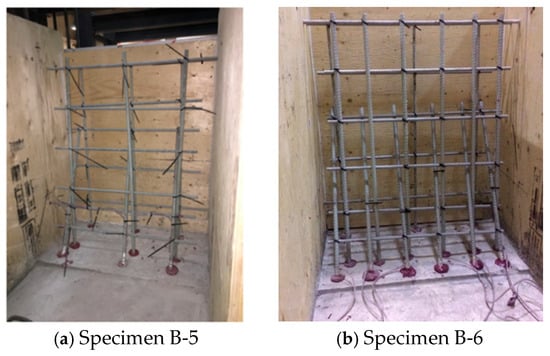
Figure 4.
Postinstalled barrier walls before casting for specimens B-5 and B-6.
2.2. Material Properties
2.2.1. Concrete
All specimens were cast using ready-mix concrete with a target compressive strength of 35 MPa, with a Target slump = 150 mm. The quantities of the Cement Type GU, sand, and 20 mm aggregate were taken as 390, 733, and 1070 kg/m3, respectively. The water content was 155 L/m3, the air voids were at 6.5%, the high-range water-reducing admixture, was 400 mL/m3, while the MasterAir, which is the air-entraining admixture, was 230 mL/m3.
To determine the concrete’s strength, three 100 × 200 mm concrete cylinders were collected from the concrete used in the casting of each barrier. Subsequently, the cylinders were tested on the same day the barrier specimens were loaded to failure. The test specimens were cast with two different patches. The first batch involved casting the four specimens having preinstalled TL-5 barriers (B-1, B-2, B-3, and B-4), as well as the deck slab for specimens B-5 and B-6. Then, the second batch was used for casting the barrier walls for specimens B-5 and B-6. For the postinstalled barrier specimens (B-5 and B-6), the ideal condition would have been to have concrete of the same strength at the time of testing for both the slab and wall. Cylinder testing data showed that the concrete strengths achieved between the two different segments were relatively close, as shown in Table 1. To consider the deviation of the strength value of each cylinder with the average value and the number of tested cylinders, the concrete characteristic strength was calculated using the following equation specified in CHBDC for bridge evaluation [62].
where = average cylinder strength, V = coefficient of variation of cylinder strengths, n = number of cylinders tested, and = coefficient of variation modification factor for concrete, taking into account the number of tested cylinders (1.47) for three samples. Table 1 summarizes the values for concrete compressive strength at the time of testing for all specimens.

Table 1.
Concrete compressive strength at the time of testing for all specimens.
2.2.2. GFRP Bars
The GFRP bar for both 13M and 15M is Grade III type with a minimum tensile strength of 1000 MPa, modulus of elasticity of 60 GPa, ultimate tensile strain of 1.67%, and nominal cross-sectional area of 199 mm2 per CSA-S807:18 Standard [67]. The use of headed-end GFRP bars was proposed in this research to allow for anchorage in concrete at a lower cost than the bend bars. The head of the 15M bar is 100 mm long. It begins with a wide disk of 38 mm diameter that transfers a portion of the load from the bar into the concrete. Beyond this disk, the head tapers in steps to the outer diameter of the bar as shown in Figure 5 to transfer load to the concrete by bearing. This geometry ensures optimal anchorage forces and minimal transverse splitting action in the vicinity of the head [68].
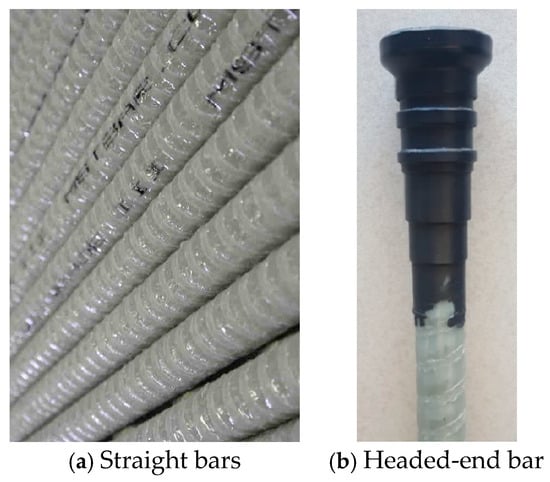
Figure 5.
Newly developed HM GFRP bar [68].
Compared to traditional anchorage methods such as 180° hooks or bent GFRP bars, headed-end GFRP bars offer notable advantages in constructability and performance. Bent GFRP bars are susceptible to strength reduction at the curved regions due to fiber misalignment, and their fabrication requires off-site forming, increasing logistical complexity. In contrast, headed-end bars provide reliable anchorage through mechanical bearing, maintain fiber continuity, and simplify installation by reducing reinforcement congestion. These benefits make them particularly suitable for barrier–deck junctions and retrofit applications, where space constraints and anchorage reliability are critical. The findings of this study reinforce the structural and practical value of headed-end GFRP bars as a preferred anchorage solution.
2.2.3. Epoxy Adhesive
The epoxy adhesive used for the postinstalled GFRP bars in specimens B-5 and B-6 exhibited a minimum bond strength of 10.8 MPa after 2 days of curing as indicated by the manufacturer [43]. Table 2 summarizes the epoxy specification as provided by the manufacturer. These properties in Table 2 represent the epoxy’s key performance indicators for structural anchorage, ensuring adequate bond strength, stiffness, and durability when used with GFRP bars in concrete substrates. The epoxy is loaded with two separate cartridges in one unit, which is mixed at the time of use. The installation of the epoxy into the concrete substrate was accomplished using a specialized Hilti manual dispenser (Hilti Corporation: Tulsa, OK, USA), commonly referred to as a caulking gun. This product, designated as HDM 500, facilitates the simultaneous dispensing of the two components of the epoxy, thereby reducing the likelihood of errors in the mixing ratio.

Table 2.
Epoxy specifications [66].
2.3. Test Setup and Instrumentation
The concrete deck of the barrier was anchored to the 1000 mm laboratory rigid floor with two 50 mm diameter threaded rods, which were spaced 600 mm center-to-center from each other. The threaded rods were tightened using specified nuts and half-inch-thick plates acting as washers at the top and bottom of the rods. Above the bolted connection was a steel-intensive setup consisting of W shapes, HSS sections, steel plates, and other custom shapes. All the steel members acted as support for the load cell and hydraulic jack. In front of the hydraulic jack was a W-shaped member reinforced with several stiffeners, and it had a robust axis aligned with the direction of the load. Behind the W-shaped member was a piece of timber stud, cut to a trapezoidal shape, to fill the gaps between the vertical end of the loading system and the tapered surface of the front face of the barrier wall. The mechanism positioned in front of the load jack was employed to create a distributed load pattern. This setup was placed at the correct height, which was 990 mm above the concrete deck. Lastly, behind the barrier was an anchored HSS section with steel plates wedged between the gap of the barrier and the steel HSS. In the case of the barrier resting on the deck slab overhang, the same HSS section was used, but additional solid cylindrical steel sections were placed beneath the barrier. These measures were used to prevent any sliding of the barriers under horizontal loading and to minimize errors in displacement readings, as shown in Figure 6a.
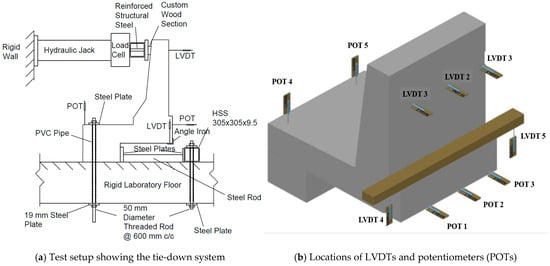
Figure 6.
Test setup.
The data acquisition unit was used to record and store the readings of all sensors during testing. A total of 10 linear variable displacement transducers (LVDTs) and potentiometers (POTs) were used in the case of a cantilevered barrier, and a total of 8 were used in the case of the barrier resting over a thick solid slab. Two POTs were used to measure the deck uplift displacement, while three POTs were used to measure the horizontal displacement of the deck slab at 500 mm from the top of the laboratory floor. Three LVDTs were used to measure displacement at a height of 1490 mm from the laboratory rigid floor level at the rear of the barrier wall, as this was the location directly behind the applied load. This setup of displacement monitoring was present for all barriers; however, barriers with a cantilevered portion had two extra LVDTs. These two extra LVDTs were installed in a position to measure the vertical deflection of the cantilevered portion of the deck slab, as shown in Figure 6b. To keep all LVDTs and POTs in their correct placements throughout testing for each barrier specimen, a wood structure was used for all sensors at the rear of the barrier, and the two POTs measuring uplift of the deck were mounted onto separate 2 × 4 timber studs, which were ultimately mounted onto external W-shaped pedestals. Three concrete strain gauges were installed at the rear of the barrier wall at a height of approximately 625 mm above the rigid floor. Barrier walls were loaded in increments of 10 kN and were held for approximately 2–3 min to allow for crack monitoring and marking. The test stopped when the specimen could not take any increase in applied loading.
3. Test Results and Discussion
Table 3 summarizes the experimental results, including failure load, maximum displacement, developed maximum tensile strain on the GFRP bars, as well as the developed maximum compressive strain on the concrete barrier wall for all specimens.

Table 3.
Experimental results.
3.1. Crack Pattern and Failure Modes
Figure 7a,b present various perspectives of the exhibited crack pattern in specimen B-1 after failure. The initial crack was detected on the front side of the barrier wall at the junction with the deck at a jacking load of 60 kN. Subsequently, a flexural crack emerged at the intersection just above the interface of the two tapered sections on the front side of the barrier wall at a jacking load of 85 kN. As loading continued, flexural cracks initiated at the barrier–deck junction when the load reached 100 kN. Although these flexural cracks at the barrier–deck junction extended deeper into the barrier thickness with increased loading, a sudden concrete breakout occurred at the embedded end of the GFRP bar at a load of 140 kN on both sides of the barrier wall. These breakout cracks propagated towards the top surface of the solid slab and the back face of the barrier wall under higher loads until the barrier could no longer withstand a jacking load exceeding 168.63 kN. To assess the damage to the bar head, the concrete surrounding the outer-headed bar was removed using a drill hammer, as illustrated in Figure 7c. Figure 7d shows the bar head with a fractured section at its largest diameter.
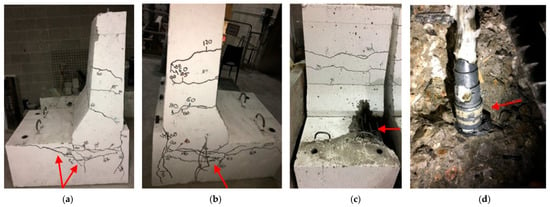
Figure 7.
Views of the crack pattern after failure for specimen B-1: (a) Right side concrete breakout; (b) Left side concrete breakout; (c) Failure of the specimen after jack hammering; (d) Close-up view of failed headed GFRP bar after jack hammering concrete at barrier–deck junction.
Specimen B-2 represents a barrier wall connected to a non-deformable concrete slab at the end location. The crack patterns observed in the tested specimen postfailure are illustrated in Figure 8a,b. The initial flexural crack became apparent on the front side of the barrier wall at the junction with the deck at a jacking load of 60 kN. Additional flexural cracks emerged above the junction of the tapered sections on the front side of the barrier wall at a jacking load of 80 kN. As the load increased, significant flexural cracking was noted in the tapered area of the barrier. At a jacking load of 140 kN, flexural cracks at the barrier–deck junction extended deeper into the barrier, indicating signs of flexural failure. However, a sudden diagonal shear failure in the concrete was observed in the upper tapered section of the barrier wall, initiating from the point of load application, at a jacking load of 170 kN on both sides of the barrier wall, as shown in Figure 8a,b. It is important to highlight that the diagonal shear crack extended through the thickness of the barrier to its rear side, resulting in concrete plugging and spalling, as illustrated in Figure 8c. The barrier was able to withstand loads up to 182.63 kN.
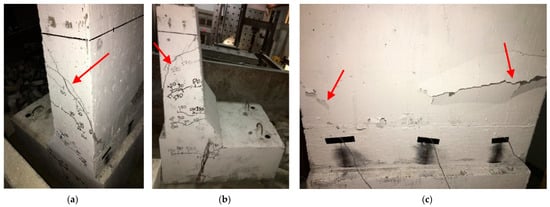
Figure 8.
Views of the crack pattern after the test specimen B-2 failed. (a) Shear crack on the right side of the barrier wall. (b) Shear crack on the left side of the barrier wall. (c) Rear side concrete crushing at the end of the shear crack on the back side of the barrier wall.
Figure 9a,b illustrate various perspectives of the crack pattern observed in specimen B-3 after failure. The initial flexural crack was detected at the junction of the tapered sections on the front side of the barrier wall, as well as at the barrier–deck interface and the fixed end of the deck slab at jacking loads of 80 kN and 60 kN, respectively. As the load increased, these flexural cracks extended further, accompanied by additional flexural cracks within the deck slab and barrier wall, as depicted in Figure 9a,b. While flexural cracks were noted in both the barrier wall and the deck slab, a sudden diagonal tension crack emerged in the deck slab at a jacking load of 90 kN. Cracks continued to propagate until the barrier could no longer withstand a jacking load exceeding 129.64 kN. Specimen B-4 represented the end location of a barrier wall supported by a deck slab overhang. The crack patterns of the tested barrier specimen following failure are illustrated in Figure 9c,d. The first flexural crack was observed at the intersection of the tapered portions of the front side of the barrier wall as well as at the barrier–deck junction and at the deck slab fixed end at 50 kN jacking load. Flexural cracks penetrated further at a higher load, along with other flexural cracks in the deck slab as appeared in Figure 9c,d. However, a sudden diagonal tension crack appeared in the deck slab at a jacking load of 90 kN, respectively. Cracks propagated further till the barrier could not sustain a jacking load beyond 163.41 kN.

Figure 9.
Views of the diagonal tension crack at the barrier–deck overhang corner after the failure of the tested specimens B-3 and B-4. (a) Right side, B-3; (b) Left side, B-3; (c) Right side, B-4; (d) Left side, B-4.
Specimen B-5 represents an interior location of a barrier wall connected to a non-deformable concrete slab using postinstalled, straight-end GFRP bars. Figure 10a,b show different views of the crack pattern of the tested barrier specimen after failure. In this specimen, the first visible crack was observed in the front side of the barrier wall at the barrier–deck junction at 30 kN jacking load, followed by a flexural crack at the intersection of the two tapered portions of the front face of the barrier wall at 70 kN jacking load. These flexural cracks penetrated through the barrier thickness with an increase in the jacking load. However, sudden concrete vertical splitting appeared approximately at the embedded GFRP bar location at a load of 140 kN, followed by signs of concrete breakout close to the end of the embedded bar in the slab at a jacking load of 159 kN. These concrete breakout cracks extended laterally in the slab and towards the back face of the barrier wall at higher loads till the barrier could not sustain a jacking load beyond 159.74 kN. Specimen B-6 represents an end location of the barrier wall connected to a non-deformable concrete slab using postinstalled, straight-end GFRP bars. The amount of vertical reinforcement at the front face was doubled to represent the case of an end segment of the barrier wall as depicted in Figure 4b. Figure 10c,d show different views of the crack pattern of the tested barrier specimen after failure. The first visible crack was observed in the front side of the barrier wall at the barrier–deck junction at 20 kN jacking load, followed by a flexural crack at the intersection of the two tapered portions of the front face of the barrier wall at 60 kN jacking load. These flexural cracks penetrated through the barrier thickness with an increase in the jacking load. Nevertheless, a sudden shear crack appeared at the middle of the top tapered portion of the barrier wall at a jacking load of 180 kN and the specimens could not absorb the jacking load beyond 186.74 kN.
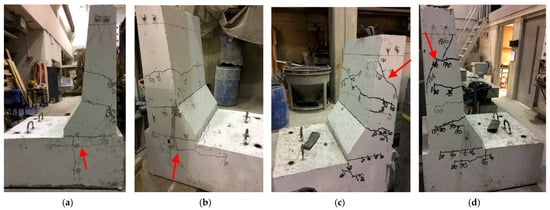
Figure 10.
View of the crack pattern after the test specimens B-5 and B-6 failed. (a) Right side concrete breakout, B-5; (b) Left side concrete breakout, B-5; (c) Diagonal shear failure at top right side of barrier wall, B-6; (d) Diagonal shear failure at top left side of barrier wall, B-6.
3.2. Load–Displacement Relationships
Figure 11 illustrates the relationship between the jacking load and displacement for all specimens at the preassigned locations, as shown in Figure 6. For specimen B-1, the average uplift of the deck slab and the horizontal displacement at failure were recorded at 0.39 mm and 3.81 mm, respectively. These measurements are deemed acceptable and do not significantly influence the structural performance of the barrier wall. The maximum lateral deflection of the barrier wall at failure is noted to be 26.32 mm, as referenced in Figure 11a, which is relatively minor considering the presence of a non-deformable deck slab. In the case of specimen B-2, where the sustained load increased due to a greater amount of longitudinal reinforcement at the end location, the average uplift of the deck slab and the horizontal displacement at failure rose to 1.62 mm and 4.27 mm, respectively. It is noteworthy that the maximum lateral deflection of the barrier wall at failure is 23.74 mm, as shown in Figure 11b, which is smaller than that observed for specimen B-1, despite the increase in the ultimate load.
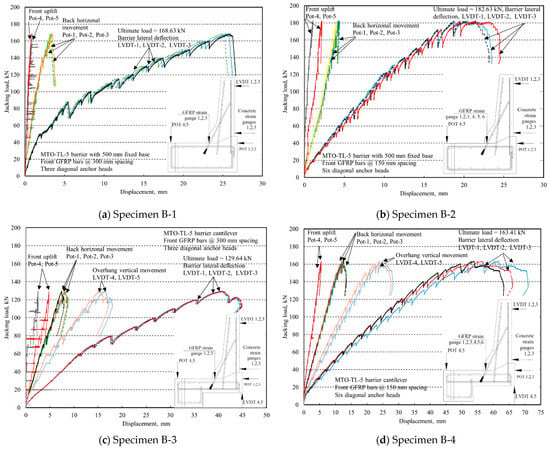
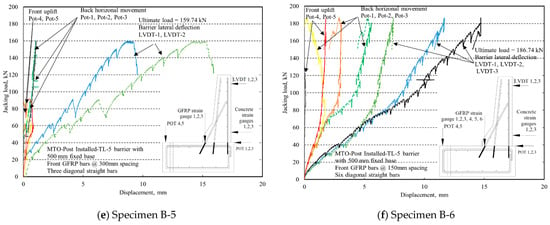
Figure 11.
Load–displacement relationships for all specimens.
Regarding the interior location of a barrier–deck slab overhang system, as for specimen B-3, the average uplift of the deck slab and the horizontal displacement at the point of failure were measured at 3.66 mm and 8.43 mm, respectively. These measurements surpass those observed in other specimens (B-1 and B-2) due to the less effective tightening of the threaded rods compared to specimens B-1 and B-2. Nonetheless, these measurements can later be utilized to determine the net lateral deflection of the barrier. It is noteworthy that the maximum lateral deflection of the barrier wall at failure reached 44.75 mm, as illustrated in Figure 11c, while the maximum vertical deflection of the deck slab overhang was recorded at 17.57 mm. In contrast, for the end location represented by specimen B-4, the average uplift of the deck slab and the horizontal movement at failure rose to 5.3 mm and 13.42 mm, respectively. These values exceed those of specimen B-3, attributable to the increased failure load. The maximum lateral deflection of the barrier wall at failure was 66.76 mm, while the vertical deflection of the deck slab overhang was 27.88 mm, as shown in Figure 11d.
A comparison of the responses from barrier walls utilizing postinstalled GFRP bars and those with preinstalled GFRP bars indicates that, in most instances, the responses associated with postinstalled bars were lower than those of the preinstalled bars. This trend was observed for both interior and end locations. In the case of specimen B-5, the average uplift of the deck slab and the horizontal displacement at failure measured 0.97 mm and 0.73 mm, respectively, which are regarded as minimal values. Likewise, the maximum lateral deflection of the barrier wall at failure was recorded at 8.92 mm, as illustrated in Figure 11e. For specimen B-6 at the end location, the average uplift of the deck slab and the horizontal movement at failure were 0.96 mm and 3.46 mm, respectively, with the maximum lateral deflection of the barrier wall at failure reaching 11.28 mm, as shown in Figure 11f. It is important to note that the failure loads for both scenarios were comparable, with a variation of no more than 5%.
Specimen B-5 showed notably lower lateral and vertical displacements compared to deck-overhang specimens. This difference is due to the increased stiffness provided by the thick, non-deformable concrete slab base, which limited barrier rotation and uplift under load. In contrast, the deck-overhang specimens (e.g., B-3, B-4) experienced greater deflections due to cantilever flexibility. The results demonstrate that barrier systems anchored to rigid slabs offer enhanced resistance to displacement, validating the improved stiffness of postinstalled GFRP bars in non-deflectable deck conditions.
3.3. Load–GFRP Bar Tensile Strain Relationships
Strain gauges were fixed at the upper surface of the deck, specifically at the junction between the barrier and the deck, for all specimens to assess the tensile strain developed in the GFRP bars. Figure 12 illustrates the tensile strains observed in the diagonal GFRP bars located at the front face of the barrier under loading conditions. It is important to note that only three strain gauges were utilized for the interior specimens (B-1, B-2, and B-3), while six strain gauges were employed for the specimens at the end locations (B-2, B-4, and B-6). The average tensile strains recorded in the GFRP bars were 6504, 4765, 5802, 5495, 15,848, and 7226 με for specimens B-1, B-2, B-3, B-4, B-5, and B-6, respectively. According to the manufacturer’s certification data sheet, the ultimate strain for the GFRP bars is 16,700 με. Consequently, none of the specimens reached the maximum tensile strain at the measurement location, except specimen B-5. Although the experimental ultimate strain observed in specimen B-5 was slightly lower than the specified ultimate strain for the GFRP bars in the manufacturer’s datasheet by 5%, tensile rupture did not occur in the GFRP. This is attributed to the fact that the design values provided by the manufacturer are based on statistical data, which indicates that the characteristic tensile strength of the bar is lower than the mean value.
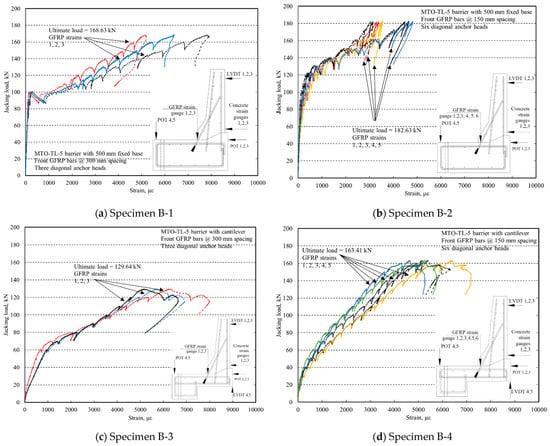
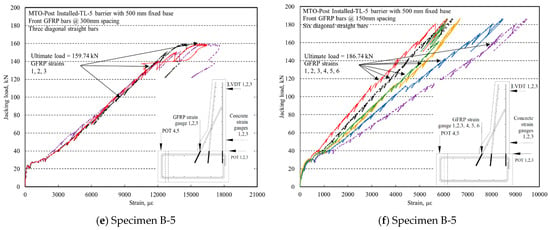
Figure 12.
Load–GFRP bar strain relationships for all specimens.
3.4. Load–Concrete Strain Relationships for All Specimens
The developed concrete compressive strains were measured using strain gauges positioned 115 mm above the deck overhang’s upper surface and at the barrier wall’s front face at three distinct locations, as illustrated in Figure 8c. Figure 13 presents the load–concrete strain relationships for all tested specimens. The average concrete compressive strains at the point of failure were recorded as 818, 868, 688, 1045, 893, and 701 με for specimens B-1, B-2, B-3, B-4, B-5, and B-6, respectively. These values are significantly lower than the ultimate concrete compressive strain at failure, which is 3500 με. The observed low strain values can be attributed to the failure of the barrier–deck junction consistently occurring at locations distant from the measurement points.

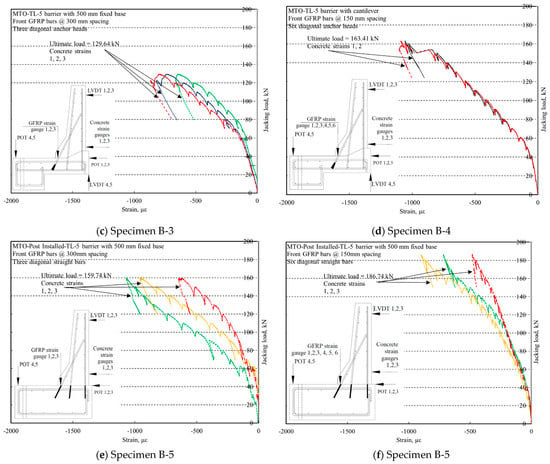
Figure 13.
Load–concrete strain relationships for all specimens.
Strain data indicated that neither concrete nor GFRP bars reached their ultimate strain capacities prior to failure. Maximum concrete compressive strains remained well below 3500 με, and GFRP bar tensile strains were below the 1.67% rupture threshold. These findings confirm that failure occurred due to concrete cracking or GFRP bar pullout, not GFRP bar rupture. In overhang systems, diagonal tension cracks controlled failure, while in thick deck slabs, pullout failure dominated.
3.5. Barrier Maximum Moment Associated with the Diagonal Tension Crack in the Deck Slab Overhang
Upon the cracking of a reinforced concrete joint, the joint behaves as a composite structure composed of both concrete and reinforcement, making its analysis significantly more complex than that of homogeneous materials [69]. The failure at the joint may occur due to diagonal tension cracks, which arise when tensile stresses from external flexural moments are not adequately countered by the reinforcement, and when appropriate reinforcement configurations are lacking. Figure 14a illustrates the diagonal tensile crack in the deck overhang under the barrier wall due to the influence of a transverse load, Ft, while Figure 14b depicts a free-body diagram of the associated forces that develop the diagonal crack. Figure 14c depicts the stress distribution at the corner joint of the barrier wall resulting from the applied moments in both the wall and the deck slab. The bending stress, σx, reveals a high tensile stress at the inner corner of the joint, suggesting the potential for crack initiation at this location under minimal loading conditions. Conversely, the stresses perpendicular to the bending stresses, σy, generate tensile stresses that lead to diagonal cracking across the corner joint. Such diagonal tension cracks can precipitate abrupt failure unless suitable reinforcement arrangements are implemented in these critical areas [69].
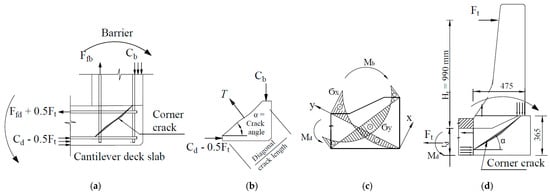
Figure 14.
Forces and stresses due to diagonal tension failure at the barrier wall deck slab junction. (a) Internal forces; (b) Free-body diagram; (c) Stress distribution along and normal to the diagonal crack indicating tensile stresses (positive sign) and compressive stresses (negative sign); (d) Diagonal crack length measurement.
As shown in Figure 14a, the applied transverse load, Ft, produces a moment at the centerline of the deck overhang (i.e., mid-depth of the deck overhang), Mb, which is equated with the deck overhang internal couple as follows:
where Ht is the height of the applied transverse vehicle impact load from the top surface of the deck slab overhang, Cd is the resultant compressive force in the deck section at the inner side of the barrier wall, td is the deck overhang thickness, dd is the effective depth of the deck overhang, and the distance between the resultant compressive and tensile forces is approximately taken as 0.9dd.
Mb = Ft (Ht + 0.5td) = (Cd − 0.5Ft). 0.9dd
Analyzing forces parallel to the diagonal crack in Figure 14b leads to the following equation.
where is the inclination of the diagonal tension crack and Cb is the resultant compressive force in the barrier wall. To calculate the diagonal crack angle between Cb and (Cd − 0.5Ft) forces, it is conversative to assume their locations are approximately 0.9 times the barrier thickness at the barrier–deck interface and 0.9 times the deck slab thickness at the inner face of the barrier wall, respectively, as depicted in Figure 14d.
Cb.sinα = (Cd − 0.5Ft).cosα
Equation (3) is rearranged as follows.
By analyzing forces normal to the diagonal crack in Figure 14b, the tensile force creating the diagonal crack, T, is calculated as follows:
T = Cb.cosα + (Cd − 0.5Ft).sinα
Substituting Equation (4) in Equation (5) yields the following equation.
(Cd − 0.5Ft) = T.sinα
The modulus of rupture of concrete, fr, is calculated as follows [70].
where = concrete density factor and = concrete compressive strength.
The tensile capacity for a concrete section of width b at the diagonal crack is calculated as follows, considering a parabolic distribution of the tensile stress along the diagonal crack length, ℓdc.
By substituting equations 6 and 8 into Equation (2), the maximum moment at the centerline of the deck overhang at the inner side of the barrier wall is as follows.
Mb = 0.6 fr·b·dd·ℓdc·sinα
Equation (9) is applied to specimens B-3 and B-4 where the barrier is mounted over a deck overhang. The concrete compressive strengths are taken as the characteristic values in Table 1, with 39.4 MPa and 43.57 MPa for specimens B-3 and B-4, respectively. For a concrete cover to the center of the GFRP bar in the tension side of the deck overhang of 58 mm, the effective depth, dd, is taken as 192 mm. The width of the section is taken as 1000 mm. Per Figure 14d, the diagonal crack angle was calculated as 37.5°. The maximum moments at the deck overhang centerline when the diagonal tension crack occurs are 142 kN.m/m and 150 kN.m/m, for specimens B-3 and B-4, respectively. The corresponding experimental ultimate moments are taken as the maximum experimental transverse load in Table 3 times (Ht + 0.5td), which is (0.99 + 0.25/2 = 1.115 m). Thus, this leads to corresponding experimental ultimate moments of 161 kN.m/m and 203 kN.m/m for specimens B-3 and B-4, respectively. The ratios between the experimental ultimate moment and the theoretical moment are 1.13 and 1.36 for specimens B-3 and B-4, respectively. When using the average concrete compressive strength rather than the characteristic values in Table 1, the ratios between the experimental ultimate moment and the theoretical moment are 1.04 and 1.24 for specimens B-3 and B-4, respectively. One may observe that Specimen B-3 and B-4 are identical except that the vertical GFRP bars at the front of the barrier are doubled in the latter, and the middle vertical bars pass through the diagonal crack at the deck-barrier corner. This may be the reason the experimental–theoretical moment ratio for specimen B-4 is greater than that of B-3. In any case, the moment ratios of being slightly more than 1 confirm the applicability of the developed equation 8 in the design to preclude the failure due to diagonal tension crack at the barrier–deck corner.
4. Moment Capacity-to-Demand Ratio at the Barrier–Deck Anchorage
Given the width of the barrier of 900 mm and the height of the applied load over the top surface of the deck slab of 990 mm, the experimental resisting moments are calculated as 186, 201, 143, 180, 176, and 205 kN.m/m, respectively, for specimens B-1, B-2, B-3, B-4, B-5, and B-6. These experimental values were then compared to the analytical resistances calculated using the equations proposed in the existing literature. For the TL-5 barrier wall, which is rigidly connected to a non-deformable concrete deck slab, the experimental findings are compared with those calculated by [64] Conversely, for the barrier wall connected to a slab overhang, the results were compared with those presented by [63], considering a 10 m long continuous barrier in the direction of traffic, as detailed in Table 3. Results show that the capacity-to-demand ratios were 1.51, 1.4, 1.38, 1.43, 1.43, and 1.42 for specimens B-1, B-2, B-3, B-4, B-5, and B-6, respectively. These values are much greater than 1, underscoring the adequacy of the GFRP detailing at the barrier–deck joint.
Because the long-term exposure to various environmental conditions may reduce the tensile strength, creep rupture, and fatigue endurance of GFRP bars [71], the 2018 edition of the AASHTO LRFD Bridge Design Guide Specifications for GFRP-Reinforced Concrete [72] specifies environmental factors of 0.8 and 0.7 for concrete not exposed or exposed to earth or weather, respectively. Benmokrane et al. [73] determined that an environmental reduction factor value of 0.85 was appropriate for GFRP bars based on a compiled database of 361 accelerated aging tests of unstressed bars. The 2024 Guide for the Design and Construction of Structural Concrete Reinforced with Fiber-Reinforced Polymer (FRP) Bars, ACI 440.1R-24 [74], adopted this environmental reduction factor for concrete both exposed and not exposed to earth or weather. In this research, an environmental reduction factor of 0.85 was applied to the capacity-to-demand ratios in Table 3. This leads to capacity-to-demand ratios of 1.28, 1.19, 1.17, 1.22, 1.22, and 1.21 for specimens B-1, B-2, B-3, B-4, B-5, and B-6, respectively. These values are still greater than 1, underscoring the adequacy of the GFRP detailing at the barrier–deck joint.
5. Applicability of Static Testing to Dynamic Crash Performance
While static testing does not replicate the strain rate effects and inertia forces present during actual crash events, it remains a widely accepted method for evaluating the ultimate capacity and failure mechanisms of structural components. In fact, static load testing has been used in prior qualification studies of GFRP-reinforced barriers (e.g., [26,28,29,30,32]) to complement full-scale crash testing and to validate design assumptions under controlled conditions.
The Canadian Highway Bridge Design Code, CHBDC [62], specifies that barrier design is to be based on the use of relevant and existing full-scale crash test data as well as a commonly used method for ensuring that the barrier design satisfies the crash test requirements. CHBDC specifies that changes to the details of a traffic barrier or traffic barrier transition that meet the crash test requirements may be made, provided that any changes affecting the geometry, strength, or behavior of the traffic barrier can be demonstrated not to adversely affect vehicle–barrier interaction. The CHBDC clause for barrier anchorage to the deck states that the suitability of a traffic barrier anchorage shall be based on its performance during crash testing of the traffic barrier. For an anchorage to be considered acceptable, significant damage shall not occur in the anchorage or deck during crash testing. If crash testing results for the anchorage are not available, the anchorage and deck shall be designed to resist the maximum bending, shear, and punching loads that can be transmitted to them by the traffic barrier, except that these loads need not be taken as greater than those resulting from the CHBDC traffic loads (i.e., equivalent transverse vehicle impact loading). This can be achieved by conducting static tests to collapse on the anchorage and/or performing analysis using an approved numerical method such as finite-element computer modeling.
The commentaries of CHBDC suggest the following examples where changes may potentially be acceptable: (a) changes to an anchorage system, where failure of the anchorage is not exhibited during crash testing and the strength of the replacement anchorage is determined to be equivalent to that of the original, and (b) substituting materials with properties identical or superior to the original material as far as behavior during crash testing is concerned.
In conclusion, although dynamic effects such as inertia and strain-rate sensitivity were not directly simulated, the static testing methodology employed in this research is consistent with accepted engineering practices for validating ultimate capacity and failure mechanisms. The GFRP-reinforced systems demonstrated performance exceeding factored design loads, and their structural adequacy was further corroborated by previous full-scale crash tests cited in the study. Therefore, the findings remain applicable to real-world crash scenarios, especially in conjunction with the design provisions and interpretive clauses of the CHBDC that allow for such validation methods.
6. Pullout Strength of GFRP Bars
To quantify the pullout capacity of the GFRP bars used in the experimental program, two cases were considered: preinstalled and postinstalled. In the case of preinstalled bars, a reinforced concrete slab of 1300 mm width, 7500 mm length, and 300 mm thickness, having an average concrete strength of 40 MPa, was prepared and cast. Steel bars of 15M in size and spacing of 300 mm center-to-center were used to reinforce the slab in both directions at the top and bottom. The cast concrete slab had three separate regions to allow for testing different bar configurations, namely: (i) preinstalled GFRP bars with straight ends, (ii) preinstalled GFRP bars with headed ends, and (iii) preinstalled GFRP bars with headed-end and unbonded straight portion. These regions are marked as Groups 1 through 3 in Figure 15a. Group 1 of bar pullout testing consisted of five straight GFRP bars, which are fully bonded to concrete with an embedment length of 195 mm; Group 2 incorporates the same type and number of headed fully bonded bars for the entire 247 mm embedment length. Group 3 consisted of five headed-end GFRP bars, which were not fully bonded to the concrete. The total embedment length of the bar was taken as 247 mm from the top of the slab; however, only the bottom 100 mm was fully bonded to the concrete. To achieve the unbonded condition, pipe insulation foam was used to wrap around the top 147 mm of the embedded length of the bar as depicted in Figure 15b. The reasoning behind using these conditions is to investigate the true pull-out strength contribution of the added anchor head.
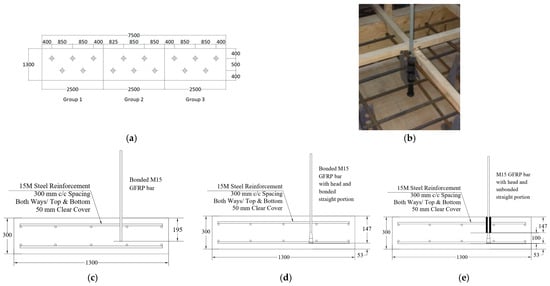
Figure 15.
Layout and slab formwork with steel and GFRP reinforcement before casting for preinstalled GFRP bars: (a) Plan of the concrete slab showing preinstalled GFRP bar locations; (b) Headed bar with unbonded straight portion; (c) Group 1: GFRP bars with straight ends; (d) Group 2: Headed-end GFRP bars; (e) Group 3: Headed-end GFRP bars with unbonded straight portion.
As for postinstalled bar pullout capacity testing, the same slab used for preinstalled bar testing was utilized. After testing the preinstalled GFRP bars, two bar groups were installed in the deck slab in locations marked with solid circles in Figure 16. Every group utilizes the same #5 bar, though with varying embedment lengths. Specifically, Groups 1 and 2 employed embedment lengths of 150 mm and 195 mm, respectively. Each group comprised 5 bars, resulting in a cumulative total of 15 bars, which includes an additional 5 bar specimens.
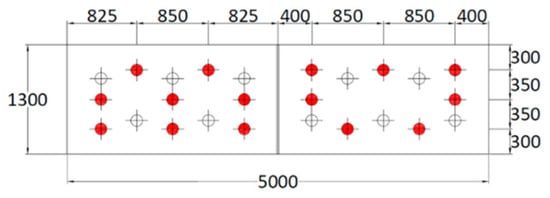
Figure 16.
Plan of concrete slab showing GFRP postinstalled bar locations.
In the process of installing the postinstalled GFRP bars, a hole was initially created using a concrete impact drill. A drill bit with a diameter of 27 mm was selected to accommodate the #5 bar size and ensure a proper bond between the epoxy, bar, and concrete components. A mark was placed on the drill bit to denote the necessary depth for each group of bars. Following the drilling, the hole was thoroughly cleaned; this involved using compressed air to remove all concrete debris, followed by scrubbing the entire hole with a brush and applying compressed air again. This cleaning procedure was conducted five times before the epoxy injection. After injecting epoxy to approximately three-quarters of the hole’s depth, the GFRP bar was carefully positioned by applying pressure while simultaneously rotating the bar in a back-and-forth motion. Figure 17 illustrates the steps of installing the GFRP bars within the slab.

Figure 17.
Installation procedure for postinstalled GFRP bars: (a) Postinstalled holes after drilling; (b) Cleaning of postinstalled barrier anchor holes; (c) Injecting epoxy into the drilled hole; (d) Installing the GFRP bar while slowly rotating left and right; (e) Final view of the preinstalled bars in the slab.
The pullout test follows the ASTM E488/E488M-15 test method [75], which describes all appropriate equipment and setup needed to experiment. The test setup consisted of a series of HSS sections resting on metal bearing plates that were spaced in a manner so that there was a minimum clearance radius of about two times the bar embedment length from the bar being tested to each support. Three HSS sections were stacked on top of one another on one side of the bar and in a parallel fashion on the opposite side of the bar, all of which were resting on four square metal plates. On top of these six HSS sections were two longer HSS sections, which were perpendicular to the supporting HSS members, while the GFRP bar of interest was centered between them. On top of these two sections is a series of plates, a rubber pad, a load cell, a hydraulic jack, and pull-out grips. This setup is demonstrated in Figure 18. Once the rigorous steel setup is complete, a potentiometer (POT) was placed adjacent and connected to the bar, while the tip of the needle was on the top of the concrete, as shown in Figure 18.
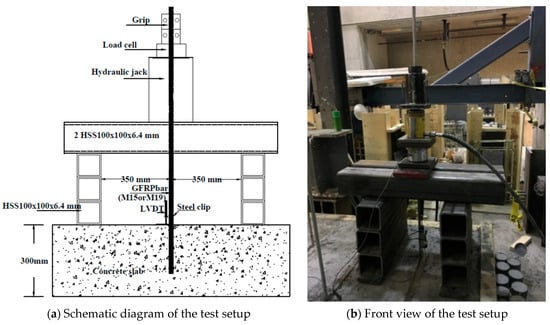
Figure 18.
Pullout test setup.
Test results showed that the straight bars failed primarily due to bar crushing at the grip location to the extent that the part split laterally along the free-standing length between the grips and the top of the concrete slab, as depicted in Figure 19a. Although the bars did not manage to achieve their nominal ultimate tensile capacity, and the bar did not visually appear to slip out of the concrete, the test results showed an average pullout force of 146.76 kN, as listed in Table 4, which is about 73% of the tension capacity of the bar. After pullout tests, concrete core samples were taken at the bar location, as shown in Figure 19b. Subsequently, the core samples were sliced in half using a concrete saw, as shown in Figure 19c. The intent of slicing the samples directly in half (cutting the GFRP bar in half as well) was to examine whether any slippage or other forms of failure within the concrete matrix occurred during the test. Figure 19d shows that the bar had no visual slippage at its end in the concrete slab. The bar appeared to be fully bonded to the concrete surrounding after the test.
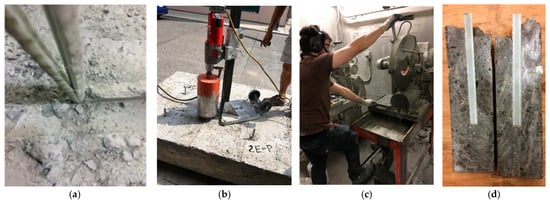
Figure 19.
Failure modes for Group 1 for preinstalled GFRP bars. (a) Bar rupture at grip area; (b) Coring of the slab; (c) Slicing the core; (d) Sliced core without bar slip.

Table 4.
Summary of bar pullout strength and associated failure modes.
Test results showed that the headed-end bars with a fully bonded straight portion failed primarily due to bar crushing at the grip location to the extent that the part split laterally along the free-standing length between the grips and the top of the concrete slab. Despite the bars failing to reach their nominal ultimate tensile capacity and the absence of any visible slippage from the concrete, the test results indicated an average pullout force of 153.5 kN, representing approximately 76% of the bar’s tension capacity. Table 4 summarizes the pullout capacity of each bar in Group 2, along with the corresponding mode of failure. As shown in Figure 20a, the bar appeared to be fully bonded to the concrete surrounding after the test. Also, no fracture in the anchor head was observed. Moreover, no shear failure was visually observed at the bar-head interface. As for the headed-end bars with the unbonded straight portion, failure was primarily due to bar slippage from the end head as shown in Figure 20b at an average pullout force of 131.04 kN (about 66%). Comparing the results of Groups 2 and 3, one may observe that the bonded straight portion of the bar increased the pullout capacity by 10% beyond the pullout force of the headed end alone.
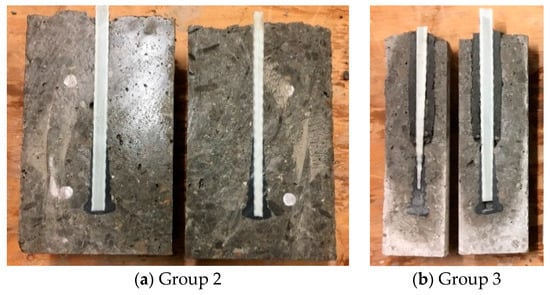
Figure 20.
Sliced core sample for Groups 2 and 3 for preinstalled GFRP bars: (a) Complete bond between GFRP bar and its head; (b) View of the sliced core samples for Group 3 showing bar slip from the head.
As for the postinstalled GFRP bars, test results indicated that the straight bars, installed with an embedment length of 150 mm, predominantly failed due to slippage at the interface between the bar and adhesive. Additionally, the bars ruptured at the anchorage point outside the concrete specimen, as illustrated in Figure 21a,b. Visual evidence of bar slippage at the bar-adhesive interface was noted, while the adhesive appeared to be fully bonded to the surrounding concrete following the test. Furthermore, no slippage was observed between the adhesive and the concrete. An increase in embedment length to 195 mm led to a rise in tensile force; however, the mode of failure remained largely consistent, as demonstrated in Figure 21a and summarized in Table 4.

Figure 21.
Failure modes for Groups 1 and 2 for postinstalled GFRP bars. (a) Bar rupture, bar slippage from concrete, and sliced specimen in Group 1; (b) Bar slippage and sliced bar in Group 2.
It can be inferred that the pullout strengths of postinstalled GFRP bars are comparable to those of GFRP-headed bars. A significant finding was that all test results indicated a pullout strength of no less than 100 kN, thereby ensuring the suitability of headed GFRP bars for use in bridge construction, per the guidelines set forth by the Ministry of Transportation of Ontario.
The reported experimental pullout strength investigation complements the structural performance results of the full-scale barrier–deck tests. This enables direct comparison between measured pullout capacities and the tensile demand from transverse vehicle impact, as predicted by applied moment equations presented elsewhere [63,64]. Presenting global performance first, followed by anchorage-specific validation, provides a logical flow from system behavior to component-level reliability. This structure enhances the practical relevance of the results for design verification and future research applications.
While previous studies have explored the bond behavior and pullout strength of headed-end GFRP bars, this study advances the field by integrating high-modulus (HM) headed-end GFRP bars into full-scale TL-5 barrier–deck systems and validating their performance under realistic transverse loading conditions. The research uniquely quantifies the contribution of the bonded straight portion to pullout strength, demonstrating about a 10% increase compared to unbonded configurations. Additionally, it benchmarks the performance of postinstalled bars against preinstalled alternatives, confirming their viability for retrofit applications. These findings are supported by statistically consistent pullout test results and capacity-to-demand ratios exceeding CHBDC requirements, even after applying environmental reduction factors. This comprehensive approach bridges the gap between component-level anchorage behavior and system-level structural performance, offering a validated and constructible solution for both new and rehabilitated bridge barriers.
7. Conclusions
This study comprehensively evaluated the structural performance and anchorage behavior of high-modulus (HM) GFRP-reinforced TL-5 concrete bridge barriers under transverse loading. Both preinstalled and postinstalled GFRP bar configurations were examined through full-scale testing and direct pullout experiments. The findings validate the use of GFRP reinforcement for new construction and retrofit applications, offering a corrosion-resistant and structurally reliable alternative to conventional steel reinforcement.
The following are the key findings from this research.
- Structural Adequacy: All six full-scale TL-5 barrier–deck specimens exceeded the factored design moments per CHBDC, with capacity-to-demand ratios ranging from 1.38 to 1.51. Even after applying an environmental reduction factor of 0.85, all ratios remained above 1.17, confirming the robustness of the GFRP anchorage systems.
- Embedment Length: A 195 mm embedment length was sufficient for both preinstalled and postinstalled GFRP bars, meeting or exceeding the required anchorage strength in all configurations.
- Headed-End Performance: Headed-end GFRP bars demonstrated superior pullout strength compared to straight-end bars. When combined with a bonded straight portion, the pullout capacity increased by approximately 10%, consistently surpassing the 100 kN threshold required by MTO.
- Failure Mechanisms: Observed failure modes on the tested actual-size barrier–deck specimens included concrete breakout at the deck-barrier corner or diagonal shear in the barrier wall. No GFRP bar rupture was recorded, and strain measurements confirmed that neither concrete nor GFRP bars reached their ultimate strain limits.
- Postinstalled Bar Viability: Postinstalled straight GFRP bars bonded with epoxy exhibited comparable performance to preinstalled headed bars, validating their use in retrofitting deteriorated barriers.
- Deck Overhang Behavior: Specimens with deck overhangs experienced diagonal tension cracking at the barrier–deck corner as the governing failure mode. The developed design equation for the resisting moment due to diagonal cracking (Equation (9)) showed strong agreement with experimental results, with moment ratios of 1.13 and 1.36, confirming its conservatism and applicability in design.
- Reinforcement Detailing: Doubling the vertical GFRP bars at the traffic face significantly enhanced load resistance, crack control, and deflection performance, particularly at barrier ends.
- Design Implications for Code and Standard Updates: The results support updating MTO-S110-92 Standard Drawing and CHBDC to recognize 195 mm embedment lengths for GFRP bars and to permit headed-end and postinstalled GFRP anchorage systems as structurally adequate and constructible alternatives to traditional bent bars.
Further research is required to investigate the long-term durability and vehicle impact resistance of postinstalled GFRP anchorage systems to simulate real-world service conditions. The long-term performance of epoxy-bonded GFRP anchors under thermal cycling, freeze–thaw exposure, and elevated temperature conditions requires further research. While this study focused on experimental validation, future research should incorporate finite element modeling to simulate stress distributions, crack development, and anchorage behavior in GFRP-reinforced barrier–deck systems. Such models would enable parametric analyses, support the refinement of the proposed design equation for diagonal cracking, and extend the applicability of the findings to a broader range of geometries and loading scenarios.
Author Contributions
G.D.: Methodology, Validation, Formal analysis, Investigation, Data curation, Writing—original draft, Visualization, Project administration. K.S.: Conceptualization, Investigation, Data curation, Writing—review and editing, Project administration. H.M.A.: Formal analysis, Investigation, Writing—review and editing. A.D.: Formal analysis, Writing—review and editing. All authors have read and agreed to the published version of the manuscript.
Funding
This research received no external funding.
Data Availability Statement
Data will be made available on request.
Acknowledgments
The financial support from the NSERC Engage program of the Natural Science and Engineering Council of Canada and the in-kind contribution of B&B FRP Manufacturing Inc. are greatly appreciated.
Conflicts of Interest
Author Gledis Dervishhasani was employed by the company Skampis Ltd. The remaining authors declare that the research was conducted in the absence of any commercial or financial relationships that could be construed as a potential conflict of interest.
References
- Manning, D. Corrosion Performance of Epoxy-Coated Reinforcing Steel: North American Experience. J. Constr. Build. Mater. 1996, 10, 349–365. [Google Scholar] [CrossRef]
- Smith, J.; Virmani, Y. Performance of Epoxy-Coated Rebars in Bridge Decks. Public. Roads 1996, 60, 2750012. [Google Scholar]
- Lai, D.; Raven, R. Performance of Epoxy Coated Reinforcement in Bridge Barriers Subjected to Direct Salt Splashing. In Proceedings of the 8th International Conference on Short and Medium Span Bridges, Niagara Falls, ON, Canada, 3–6 August 2010; Paper # 76. pp. 424–434. [Google Scholar]
- Islam, S.; Afefy, H.M.; Sennah, K.; Azimi, H. Bond characteristics of straight- and headed-end ribbed-surface GFRP bars embedded in high-strength concrete. Constr. Build. Mater. 2015, 83, 283–298. [Google Scholar] [CrossRef]
- Lu, J.; Afefy, H.M.; Azimi, H.; Sennah, K.; Sayed-Ahmed, M. Bond performance of sand-coated and ribbed-surface glass fiber reinforced polymer bars in high-performance concrete. Structures 2021, 34, 10–19. [Google Scholar] [CrossRef]
- Khederzadeh, H.; Sennah, K. Pullout Strength of Pre-installed GFRP Bars in Concrete. In Proceedings of the CSCE Annual Conference, Canadian Society for Civil Engineering, Montreal, QC, Canada, 29 May–1 June 2013; pp. 1–10. [Google Scholar]
- Ahmed, E.A.; El-Sayed, A.K.; El-Salakawy, E.; Benmokrane, B. Bend strength of FRP stirrups: Comparison and evaluation of testing methods. J. Compos. Constr. 2010, 14, 3–10. [Google Scholar] [CrossRef]
- Achillides, Z.; Pilakoutas, K. Bond Behavior of Fiber Reinforced Polymer Bars under Direct Pullout Conditions. J. Compos. Constr. 2004, 8, 173–181. [Google Scholar] [CrossRef]
- Baena, M.; Torres, L.; Turon, A.; Barris, C. Experimental Study of Bond Behavior between Concrete and FRP Bars using a Pull-out Test. Compos. Part B Eng. 2009, 40, 784–797. [Google Scholar] [CrossRef]
- Won, J.; Park, C.; Kim, H.; Lee, S.; Jang, C. Effect of Fibers on the Bonds between FRP Reinforcing Bars and High-Strength Concrete. Compos. Part B Eng. 2008, 39, 747–755. [Google Scholar] [CrossRef]
- Mazaheripour, H.; Barros, J.; Cruz, S.; Soltanzadeh, F. Analytical Bond Model for GFRP Bars to Steel Fiber Reinforced Self-Compacting Concrete. J. Compos. Constr. 2013, 17, 1–16. [Google Scholar] [CrossRef]
- Maranan, G.; Manalo, A.; Karunasena, W.; Benmokrane, B. Bond Stress-Slip Behavior: Case of GFRP Bars in Geopolymer Concrete. J. Mater. Civ. Eng. 2015, 27, 1–9. [Google Scholar] [CrossRef]
- Maranan, G.; Manalo, A.; Karunasena, W.; Benmokrane, B. Pullout Behavior of GFRP bars with Anchor in Geopolymer Concrete. J. Compos. Struct. 2015, 132, 1113–1121. [Google Scholar] [CrossRef]
- Ametrano, D. Bond Characteristics of Glass Fibre Reinforced Polymer Bars Embedded in High Strength and Ultra-High Strength Concrete. Master’s Thesis, Department of Civil Engineering, Ryerson University, Toronto, ON, Canada, 2011. [Google Scholar]
- Mak, C. Experimental and Theoretical Investigation of Glass Fibre Reinforced Polymer Tension Lap Splices in Ultra High Performance Concrete. Master’s Thesis, Department of Civil Engineering, Ryerson University, Toronto, ON, Canada, 2011. [Google Scholar]
- Yoo, D.-Y.; Kwon, K.-Y.; Park, J.-J.; Yoon, Y.-S. Local Bond-Slip Response of GFRP Rebar in Ultra-High-Performance Fiber-Reinforced Concrete. Compos. Struct. 2015, 120, 53–64. [Google Scholar] [CrossRef]
- Ahmed, M.S.; Sennah, K.; Afefy, H.M. Structural Behavior of Full-Depth Deck Panels Having Developed Closure Strips Reinforced with GFRP Bars and Filled with UHPFRC. J. Comp. Sci. 2024, 8, 468. [Google Scholar]
- Ahmed, M.S.; Sennah, K.; Afefy, H.M. Fatigue and Ultimate Strength Evaluation of GFRP-Reinforced, Laterally Restrained, Full-Depth Precast Deck Panels with Developed UHPFRC Filled Transverse Closure Strips. Appl. Sci. 2024, 14, 19. [Google Scholar]
- Firas, S.A.; Gilles, F.; Robert, L.R. Bond Between Carbon Fibre-reinforced Polymer (CFRP) Bars and Ultra-High Performance Fibre Reinforced Concrete (UHPFRC): Experimental study. Constr. Build. Mater. 2011, 25, 479–485. [Google Scholar]
- Benmokrane, B.; Mohamed, M.H.; Manalo, A.; Cousin, P. Evaluation of Physical and Durability Characteristics of New Headed Glass-Fiber-Reinforced-Polymer (GFRP) Bars. ASCE J. Compos. Constr. 2017, 21, 1–12. [Google Scholar] [CrossRef]
- Vint, L.; Sheikh, S. Investigation of Bond Properties of Alternate Anchorage Schemes for Glass Fiber-Reinforced Polymer Bars. ACI Struct. J. 2015, 112, 59–68. [Google Scholar]
- Vint, L. Investigation of Bond Properties of Glass Fibre Reinforced Polymer (GFRP) Bars in Concrete under Direct Tension. Master’s Thesis, Department of Civil Engineering, University of Toronto, Toronto, ON, Canada, 2012. [Google Scholar]
- Mohamed, H.; Zaki, M.; Benmokrane, B. Newly Developed FRP-Headed Rebars for Infrastructure Applications. In Proceedings of the 3rd International Structural Specialty Conference, Canadian Society for Civil Engineering, Edmonton, AB, Canada, 6–9 June 2012; pp. 1–9. [Google Scholar]
- Lu, J.; Afefy, H.M.; Azimi, H.; Sennah, K.; Sayed-Ahmed, M. Bond characteristics of glass fiber reinforced polymer bars in high-strength concrete. Struct. Build. 2022, 175, 748–764. [Google Scholar] [CrossRef]
- Johnson, D.; Sheikh, S. Experimental Investigation of Glass Fiber-Reinforced Polymer-Reinforced Normal-Strength Concrete Beams. ACI Struct. J. 2013, 113, 1165–1174. [Google Scholar] [CrossRef]
- Sennah, K.; Khederzadeh, H. Development of Cost-Effective PL-3 Concrete Bridge Barrier Reinforced with Sand-Coated GFRP Bars: Vehicle Crash Test. Can. J. Civ. Eng. 2014, 41, 357–367. [Google Scholar] [CrossRef]
- Sennah, K.; Hedjazi, S. Structural Qualification of a Developed GFRP-Reinforced PL-3 Concrete Bridge Barrier Using Vehicle Crash Testing. Int. J. Crashworthiness 2018, 24, 1–18. [Google Scholar]
- Sennah, K.; Tropynina, E.; Ibrahim, Z.; Hedjazi, S. Structural Qualification of a Developed GFRP-Reinforced PL-3 Concrete Bridge Barrier Using Ultimate Load Testing. Int. J. Concr. Struct. Mater. 2018, 12, 1–22. [Google Scholar] [CrossRef]
- Rostami, M.; Sennah, K.; Afefy, H.M. Ultimate capacity of barrier-deck anchorage in MTQ TL-5 barrier reinforced with headed-end, high-modulus, sand-coated GFRP bars. Can. J. Civ. Eng. 2018, 45, 263–275. [Google Scholar] [CrossRef]
- Khederzadeh, H.; Sennah, K. Development of Cost-Effective PL-3 Concrete Bridge Barrier Reinforced with Sand-Coated GFRP Bars: Static Load Tests. Can. J. Civ. Eng. 2014, 41, 368–379. [Google Scholar] [CrossRef]
- Sennah, K.; Mostafa, A. Performance of a Developed TL-5 Concrete Bridge Barrier Reinforced with GFRP Hooked Bars: Vehicle Crash Testing. ASCE J. Bridge Eng. 2018, 23, 1–20. [Google Scholar] [CrossRef]
- Rostami, M.; Sennah, M.; Mostafa, A. Experimental Study on the Transverse Load Carrying Capacity of TL-5 Bridge Barrier Reinforced with Special Profile GFRP Bars. ASCE J. Compos. Constr. 2019, 23, 1–16. [Google Scholar] [CrossRef]
- Hasaballa, M.; El-Salakawy, E. Seismic performance of beam-column joints reinforced with GFRP headed bars. In Proceedings of the 3rd Asia-Pacific Conference on FRP Is Structures (APFIS 2012), Sapporo, Japan, 2–4 February 2012. [Google Scholar]
- El-Badry, M.; Moravvej, M.; Joulani, P. Performance of a Hybrid FRP-Reinforced Bridge Truss Girder System – Experimental Assessment. In Proceedings of the 4th International Conference on Smart Monitoring, Assessment, and Rehabilitation of Civil Structures, SMAR 2017, Zurich, Switzerland, 13–15 September 2017; pp. 1–9. [Google Scholar]
- Lu, C.; Qi, Z.; Zheng, Y.; Xuan, G.; Yan, Y. Long-term tensile performance of GFRP bars in loaded concrete and aggressive solutions. J. Build. Eng. 2023, 64, 105587. [Google Scholar] [CrossRef]
- Zhu, P.; Li, Z.; Zhu, Y.; Wu, Y.; Qu, W. Prediction of the Long-Term Tensile Strength of GFRP Bars in Concrete. Buildings 2023, 13, 1035. [Google Scholar] [CrossRef]
- Hao, Z.H.; Zeng, J.J.; Chen, G.M.; Dai, J.G.; Chen, J.F. Durability of FRP-to-concrete bonded joints subjected to 110 months of accelerated laboratory and field exposure. Eng. Struct. 2024, 305, 117681. [Google Scholar] [CrossRef]
- Sun, J.-H.; Su, N.-J.; He, Z.-Q.; Jia, R.-X.; Liu, Y.; Lin, F.-K.; Ka, T.A. Durability of concrete-encapsulated GFRP bars subjected to seawater immersion. Case Stud. Constr. Mater. 2024, 20, e03249. [Google Scholar] [CrossRef]
- Nepomuceno, E.; Sena-Cruz, J.; Correia, L.; D'Antino, T. Review on the bond behavior and durability of FRP bars to concrete. Constr. Build. Mater. 2021, 287, 123042. [Google Scholar] [CrossRef]
- Zheng, Y.; Ni, M.; Lu, C.; Chu, T.; Wu, X. Bond Behavior of GFRP-Concrete Under Long-term Exposure to Aggressive Environments. J. Adv. Concr. Technol. 2020, 18, 730–742. [Google Scholar] [CrossRef]
- National Academies of Sciences, Engineering, and Medicine. MASH Railing Load Requirements for Bridge Deck Overhang. NCHRP Research Report 1078; The National Academies Press: Washington, DC, USA, 2023. [Google Scholar] [CrossRef]
- Frosch, R.J.; Morel, A.J. Guardrails for Use on Historic Bridges: Volume 2—Bridge Deck Overhang Design; Report No. FHWA/IN/JTRP-2016/34; Joint Transportation Research Program, Purdue University: West Lafayette, IN, USA, 2016; 109p. [Google Scholar]
- Arrington, D.R.; Holt, J.M.; Bligh, R.P. Concrete Roadside Barrier Anchorage Details for 5-in., Cast-in-Place Decks on Prestressed Beams. Transp. Res. Rec. 2012, 2313, 33–41. [Google Scholar] [CrossRef]
- Zhao, H.; Xie, Z.; Yang, B.; Li, L.; Wang, R.; Chen, W. Impact resistance performance of precast reinforced concrete barriers with grouted sleeve and steel angle-to-plate connections. Eng. Struct. 2024, 316, 118533. [Google Scholar] [CrossRef]
- Nguyen, Q.T.; Maki, T.; Mutsuyoshi, H.; Ishihara, Y. Experimental Study on Connection Between Precast Concrete Barrier and Existing Bridge Deck by Loop Steel Bars and Post-installed Anchor. In International Symposium of the International Federation for Structural Concrete; Lecture Notes in Civil Engineering; Springer: Cham, Switzerland, 2023; Volume 350. [Google Scholar] [CrossRef]
- Yu, X.; Huang, Y.; Yang, Y.; Chen, Y.; Luo, Y.; Jia, B. Optimal design for the connector of bridge prefabricated concrete barriers. Sci. Prog. 2021, 104, 1–19. [Google Scholar] [CrossRef]
- Alaywan, W.R. Performance and Analysis of Concrete Bridge Railing Using Conventional and Composite Reinforcement Materials; Report No. FHWA/LA.16/547; Louisiana Transportation Research Center: Rouge, LA, USA, 2018; 161p. [Google Scholar]
- Azimi, H.; Grégoire, M.; Liu, Z.; Bahous, A. A Precast Barrier Alternative Connected to Moment Slab for Accelerated Construction. In Proceedings of the 10th International Conference on Short and Medium Span Bridges, Quebec City, QC, Canada, 31 July–3 August 2018; pp. 1–9. [Google Scholar]
- Ecklund, A.; Sritharan, S. Precast Concrete Bridge Barriers for Accelerated Bridge Construction; Technical Report; Iowa State University: Ames, IA, USA, 2018; 103p. [Google Scholar]
- Patel, G.; Sennah, K.; Azimi, H.; Lam, C.; Kianoush, R. Development of Precast Concrete Barrier Wall System for Bridge Decks. J. Prestress. Concr. Inst. (PCI) 2014, 59, 83–102. [Google Scholar] [CrossRef]
- Coleman, Z.; Jacques, E.; Roberts-Wollmann, C. Effect of Beam Depth on Anchorage Strength of Hooked and Headed Bars. ACI Struct. J. 2023, 120, 197–206. [Google Scholar] [CrossRef]
- Cho, D.-Y.; Jeong, H.-S.; Choi, J.-W. A Study of the Bolt Connection System for a Concrete Barrier of a Modular Bridge. Int. J. Eng. Technol. Innov. 2018, 8, 107–117. [Google Scholar]
- Matta, F.; Nanni, A. Connection of Concrete Railing Post and Bridge Deck with Internal FRP Reinforcement. J. Bridge Eng. 2009, 14, 66–76. [Google Scholar] [CrossRef]
- Meda, A.; Rinaldi, Z.; Spagnuolo, S.; Grecco, R. Full-scale tests on bridge kerbs subjected to horizontal actions. Struct. Concr. 2021, 22, 813–826. [Google Scholar] [CrossRef]
- Cattaneo, S.; Crespi, P. Response of Connections between Concrete Corbels and Safety Barriers. Materials 2019, 12, 4103. [Google Scholar] [CrossRef]
- Ahmed, E.; Matta, F.; Benmokrane, B. Steel Post-and-Beam Barrier with GFRP-Reinforced Concrete Curb and Bridge Deck Connection. J. Bridge Eng. 2013, 18, 1189–1197. [Google Scholar] [CrossRef]
- Azimi, H.; Sennah, K.; Sayed-Ahmed, M.; Nikravan, N.; Louie, J.; Hassaan, A.; Al-Bayati, N. Bridge Deck-Guardrail Anchorage Detailing for Sustainable Construction. ASCE J. Bridge Eng. 2014, 19, 04014039. [Google Scholar] [CrossRef]
- Farghal, H.; Arvan, H.; Azizinamini, A. Use of All Lightweight Concrete in Conjunction with UHPC Connection for Prefabricated Barrier System; Technical Report No. ABC-UTC-2016-C4-FIU02; Florida International University: Miami, FL, USA, 2025; 39p. [Google Scholar]
- Khodayari AMantawy, I.M.; Azizinamini, A. Experimental and Numerical Investigation of Prefabricated Concrete Barrier Systems Using Ultra-High-Performance Concrete. Transp. Res. Rec. 2023, 2677, 624–634. [Google Scholar] [CrossRef]
- Rostami, M.; Sennah, K.; Azimi, H.; Afefy, H. Behavior and design of GFRP bar adhesive anchors under direct tension for deteriorated concrete bridge barrier replacement. Adv. Struct. Eng. 2025. [Google Scholar] [CrossRef]
- Azimi, H.; Sennah, K.; Tropynina, E.; Goremykin, S.; Lucic, S.; Lam, M. Anchorage Capacity of Concrete Bridge Barriers Reinforced with GFRP Bars with Headed Ends. ASCE J. Bridge Eng. 2014, 19, 1–15. [Google Scholar] [CrossRef]
- CAN/CSA-S6:19; Canadian Highway Bridge Design Code. Canadian Standards Association: Toronto, ON, Canada, 2019.
- Diab, A.; Sennah, K.; Rostami, M.; Dervishhasani, G.; Sayed Ahmed, M. Development of live load moment and tension force in bridge deck slab overhang due to transverse vehicle impact for CHBDC 2025. In Proceedings of the CSCE Annual Conference, Niagara Falls, ON, Canada, 5–7 June 2024. [Google Scholar]
- Omar, O. Investigation of Moment and Tension Force in Bridge Deck Slab Overhang in Slab-on-Girder Bridge Due to Traffic Loading; M.Eng. Project Report; Civil Engineering Department, Toronto Metropolitan University: Toronto, ON, Canada, 2024. [Google Scholar]
- MTO. Structural Manual; Ministry of Transportation Ontario, Transportation Infrastructure Management Division, Standards and Contracts Branch Structures Office: Ontario, ON, Canada, 2018. [Google Scholar]
- Hilti Canada Corporation. HIT-RE 500 V3 Epoxy Adhesive Anchoring System. In North American Product Technical Guide—Volume 2: Anchor Fastening Technical Guide, 17th ed.; Hilti Corporation: Tulsa, OK, USA, 2016. [Google Scholar]
- CSA-S807:18; Specification for Fibre Reinforced Polymers. Canadian Standard Association: Toronto, ON, Canada, 2018.
- B&B FRP Manufacturing Inc. MST-BAR® GIII Material Specification. B&B Manufacturing Inc. 2016. Available online: https://www.bandbfrp.com/ (accessed on 23 November 2016).
- Nilsson, I.H.E.; Losberg, A. Reinforced concrete corners and joints subjected to bending moment. J. Struct. Div. 1976, 102, 1229–1254. [Google Scholar] [CrossRef]
- CAN/CSA-A23.3:24; Design of Concrete Structures. Canadian Standards Association: Toronto, ON, Canada, 2024.
- D'Antino, T.; Pisani, M.A.; Poggi, C. Effect of the Environment on the Performance of GFRP Reinforcing Bars. Compos. Part B Eng. 2018, 141, 123–136. [Google Scholar] [CrossRef]
- AASHTO. AASHTO LRFD Bridge Design Guide Specifications for GFRP-Reinforced Concrete; American Association of State Highway and Building Officials (AASHTO): Washington, DC, USA, 2018. [Google Scholar]
- Benmokrane, B.; Brown, V.L.; Ali, A.; Mohamed, K.; Shield, C. A Reconsideration of the Environmental Reduction Factor CE for GFRP Reinforcing Bars. ASCE J. Compos. Constr. 2020, 24, 06020001. [Google Scholar] [CrossRef]
- ACI 440.1R-24; Guide for the Design and Construction of Structural Concrete Reinforced with Fiber-Reinforced Polymer (FRP) Bars. American Concrete Institute: Chicago, CA, USA, 2024.
- ASTM E488/E488M-15; Standard Test Methods for Strength of Anchors in Concrete Elements. American Society for Testing and Materials: Pennsylvania, PA, USA, 2015.
Disclaimer/Publisher’s Note: The statements, opinions and data contained in all publications are solely those of the individual author(s) and contributor(s) and not of MDPI and/or the editor(s). MDPI and/or the editor(s) disclaim responsibility for any injury to people or property resulting from any ideas, methods, instructions or products referred to in the content. |
© 2025 by the authors. Licensee MDPI, Basel, Switzerland. This article is an open access article distributed under the terms and conditions of the Creative Commons Attribution (CC BY) license (https://creativecommons.org/licenses/by/4.0/).